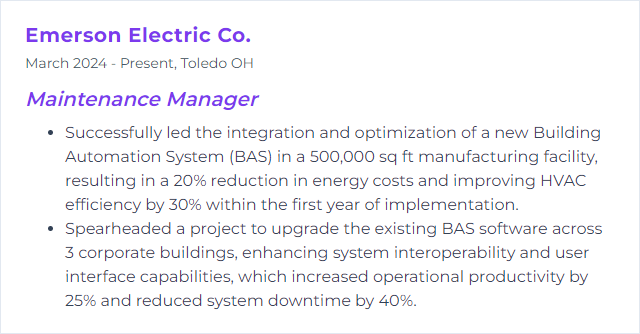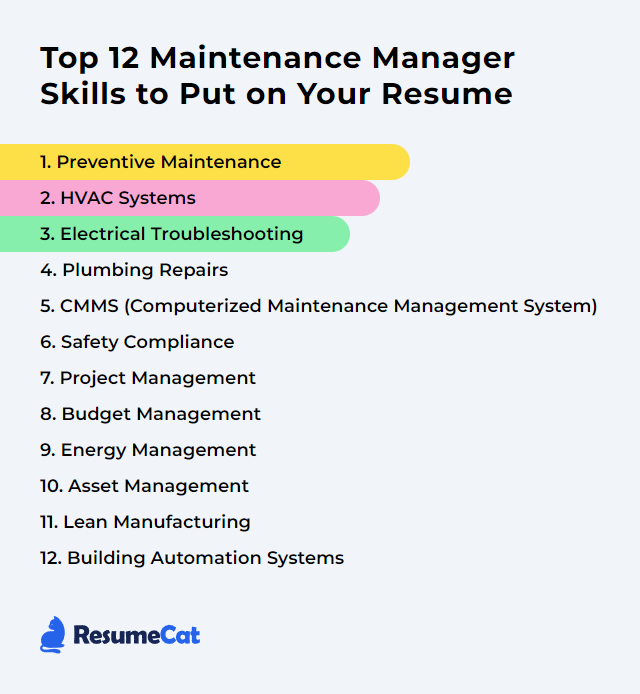Top 12 Maintenance Manager Skills to Put on Your Resume
In today’s competitive job market, standing out as a maintenance manager means showing the right mix of technical depth, leadership, and rigor. This guide walks through twelve core skills that employers watch for—practical, measurable, and immediately useful on the floor and in the boardroom.
Maintenance Manager Skills
- Preventive Maintenance
- HVAC Systems
- Electrical Troubleshooting
- Plumbing Repairs
- CMMS (Computerized Maintenance Management System)
- Safety Compliance
- Project Management
- Budget Management
- Energy Management
- Asset Management
- Lean Manufacturing
- Building Automation Systems
1. Preventive Maintenance
Preventive maintenance is a structured program of scheduled inspections, services, and parts replacement designed to avoid failures, stretch asset life, and keep operations humming without surprises.
Why It's Important
Less downtime, safer work, longer asset life, fewer emergency callouts. Costs fall. Reliability rises.
How to Improve Preventive Maintenance Skills
Baseline and prioritize: Audit current PM tasks, asset criticality, and failure history. Trim busywork, elevate what prevents real risk.
Right-size intervals: Align PM frequencies to manufacturer guidance, operating context, and data. Avoid over-maintaining low-risk assets.
Elevate skills: Train techs on precision tasks (torque, lubrication best practices, alignment) and failure modes.
Go condition-based: Layer inspections with vibration, thermography, oil analysis, or simple operator rounds to catch early warning signs.
Standardize procedures: Clear checklists, parts, tools, safety steps. Consistency reduces errors.
Close the loop: Capture findings, fix causes, update PMs. PDCA never stops.
Measure what matters: Track PM compliance, PM-to-corrective ratio, MTBF, and downtime avoided.
How to Display Preventive Maintenance Skills on Your Resume
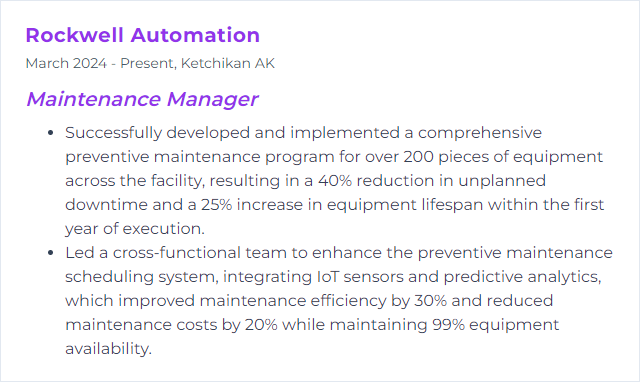
2. HVAC Systems
HVAC covers heating, ventilation, and air conditioning—comfort, air quality, and moisture control rolled into one complex ecosystem that can eat energy or save it depending on how it’s run.
Why It's Important
Comfort and health depend on it. So do energy costs, uptime, and equipment life. Poor control means waste; smart control means savings.
How to Improve HVAC Systems Skills
Routine care: Filter changes, coil cleaning, belt checks, refrigerant verification, sensor calibration. Boring, vital.
Tighten the envelope: Seal and insulate ducts, fix outside air imbalances, eliminate stray heat gain and loss.
Smarter controls: Optimize schedules, deadbands, economizers, and setback strategies. Use trend logs to tune, not guess.
Upgrade wisely: High-efficiency equipment, VFDs on fans and pumps, heat recovery where it pays.
Ventilation and IAQ: Meet current ventilation targets, manage humidity, and monitor CO2/PM where appropriate.
Commission and recommission: Verify sequences after changes. Drift happens—periodic recommissioning pulls systems back to design intent.
Mind refrigerants: Plan for new refrigerant rules and service procedures to stay compliant and safe.
How to Display HVAC Systems Skills on Your Resume
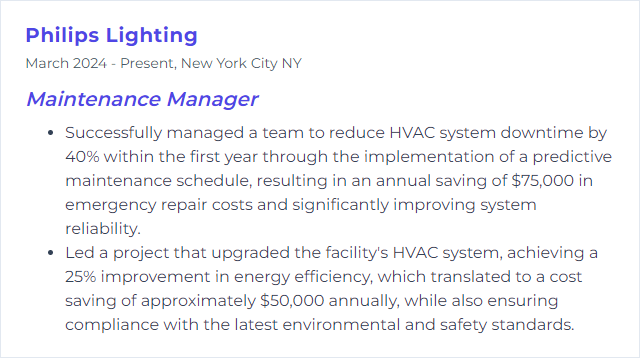
3. Electrical Troubleshooting
A disciplined hunt for faults in circuits, controls, and power systems—identify the symptom, isolate the cause, restore safely, prevent the repeat.
Why It's Important
Safety and uptime hang in the balance. Fast, correct diagnosis cuts downtime and protects equipment and people.
How to Improve Electrical Troubleshooting Skills
Master the docs: Read schematics, one-lines, and PLC I/O maps without hesitation.
Use a method: Verify power, inspect, test, hypothesize, prove, fix. No guesswork.
Instrument fluency: Multimeter, clamp meter, insulation tester, thermal camera—know when and how.
Lockout/tagout every time: Zero energy. Verify. Then work.
Focus on connections: Loose terminations, corrosion, and heat damage cause a shocking number of faults.
Document and prevent: Capture root cause and corrective actions. Update standards or PMs so it doesn’t return.
How to Display Electrical Troubleshooting Skills on Your Resume
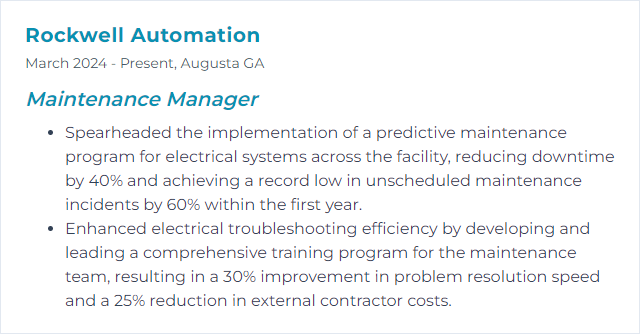
4. Plumbing Repairs
Keep water in the pipes and waste out of sight—repair leaks, clear clogs, replace worn components, and protect water quality.
Why It's Important
Plumbing failures ruin finishes, disrupt operations, and risk health. Fixes done right prevent damage and keep tenants or production flowing.
How to Improve Plumbing Repairs Skills
Skill up: Train on soldering, pressing, solvent welding, and modern materials. Know when each method fits.
Inspect proactively: Valve exercises, backflow tests, trap checks, pressure and temperature monitoring.
Use the right kit: Quality cutters, press tools, inspection cameras, leak detection gear. Tools matter.
Code and permits: Work to current plumbing and backflow standards. Document repairs and tests.
Water quality: Address hardness, corrosion, and Legionella risks with treatment and temperature control.
Standardize: Stock common parts, define repair checklists, and communicate outages clearly.
How to Display Plumbing Repairs Skills on Your Resume
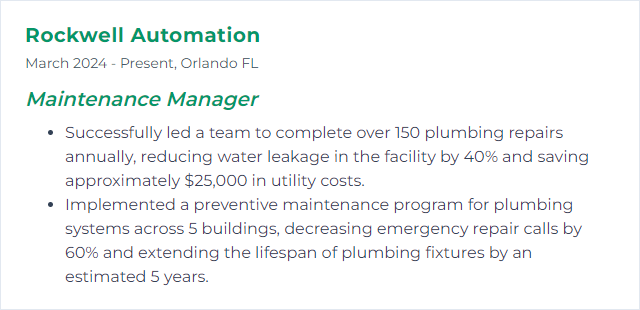
5. CMMS (Computerized Maintenance Management System)
A CMMS centralizes assets, work orders, PM schedules, inventory, and costs—your operational memory and command center in one place.
Why It's Important
It drives consistency, visibility, and speed. Better planning, better accountability, better decisions.
How to Improve CMMS (Computerized Maintenance Management System) Skills
Train and retrain: Short, role-based sessions. New features, better habits.
Clean data: Standard naming, accurate BOMs, current asset hierarchy, closed work orders with failure codes.
Integrate: Tie to ERP, BMS/BAS, and condition monitoring to reduce double entry and unlock insights.
Customize thoughtfully: Dashboards, fields, and workflows that reflect how work really happens.
Measure: Work backlog, schedule compliance, wrench time, PM/corrective mix, cost by asset.
Go mobile: Real-time updates, photos, barcodes, and offline capability on the floor.
Automate: Trigger PMs by runtime/condition, auto-reorder spares, and route approvals.
How to Display CMMS (Computerized Maintenance Management System) Skills on Your Resume

6. Safety Compliance
Build systems, training, and habits that match regulations and protect people during every task, every shift.
Why It's Important
Nothing derails operations like an injury or catastrophic event. Safe work is the foundation—legal, ethical, and practical.
How to Improve Safety Compliance Skills
Relentless training: Task-specific procedures, refreshers, and competency checks.
Job hazard analyses: Identify hazards before the work starts. Engineer them out when possible.
PPE and LOTO: Enforce availability and use. Verify isolation. No exceptions.
Permits and procedures: Confined space, hot work, elevated work—clear permits and supervision.
Walk the floor: Regular audits, observations, and immediate corrective actions.
Emergency readiness: Drills, equipment checks, and clear roles for alarms, spills, fires, and medicals.
Report and learn: Encourage near-miss reporting. Investigate root causes. Share lessons fast.
How to Display Safety Compliance Skills on Your Resume
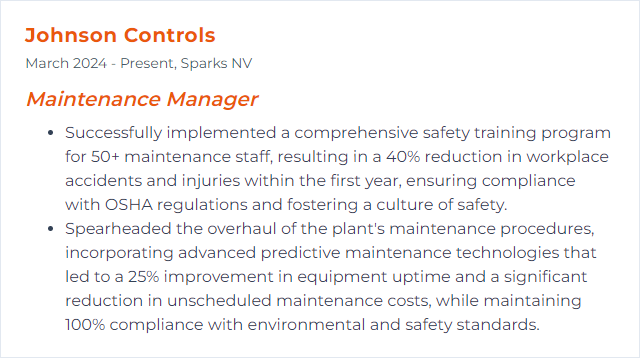
7. Project Management
Plan, execute, and close maintenance projects—upgrades, shutdowns, capital installs—on time and on budget without tripping production.
Why It's Important
Good projects create capacity and reliability. Bad projects bleed money and schedule. The difference is discipline.
How to Improve Project Management Skills
Define scope tightly: Deliverables, constraints, acceptance criteria. No fuzzy edges.
Schedule with intent: Build realistic timelines, dependencies, and milestones. Protect the critical path.
Resource smartly: Level labor, secure parts early, and lock in vendors with clear SOWs.
Manage risk: Maintain a risk register with triggers, owners, and response plans.
Control changes: Formal change control prevents scope creep and budget drift.
Communicate: Cadenced updates, visual boards, and quick decisions when conditions shift.
Close and learn: Commission, verify, hand over documentation, and run a lessons-learned session.
How to Display Project Management Skills on Your Resume
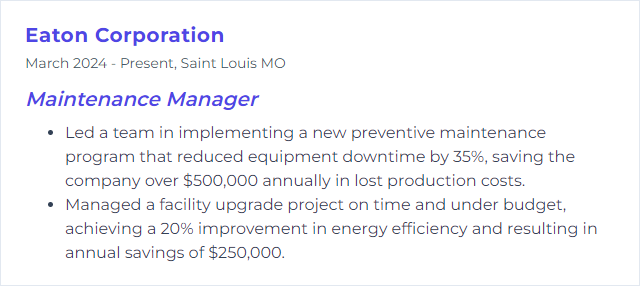
8. Budget Management
Plan, track, and steer maintenance spend—labor, spares, contracts, and capital—toward reliability and value.
Why It's Important
Money follows clarity. Strong controls turn maintenance from a cost center into a performance engine.
How to Improve Budget Management Skills
Map the cost stack: Fixed vs variable, planned vs unplanned. Know your drivers.
Build from the work: Budget from PM plans, backlog, and risk—not last year plus a percent.
Use your CMMS: Track labor, materials, and downtime by asset for accurate forecasting.
Shift the mix: Increase PM and condition-based work to shrink emergency spend.
Inventory discipline: Min/max levels, critical spares strategy, and cycle counts to cut carrying costs.
Vendor leverage: Multi-year agreements, volume pricing, and performance SLAs.
Watch variances: Monthly reviews, corrective actions, and reforecasts—no surprises in Q4.
Think lifecycle: Evaluate total cost of ownership when deciding repair vs replace.
How to Display Budget Management Skills on Your Resume
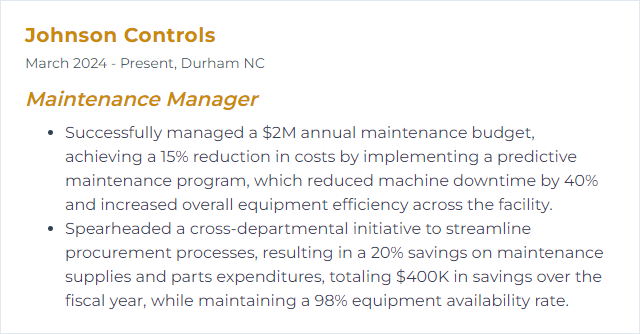
9. Energy Management
Monitor, control, and cut energy use while keeping performance steady—comfort, production, and safety intact.
Why It's Important
Lower bills, lower emissions, better equipment life. Efficiency that pays for itself and then some.
How to Improve Energy Management Skills
Audit and baseline: Know where energy goes by system and time of day. Set targets.
Tune operations: Optimize setpoints, schedules, and sequences. Eliminate simultaneous heat/cool.
Retro-commission: Find drift, fix controls, verify sensors, and recalibrate.
Targeted upgrades: LEDs, VFDs, high-efficiency motors, heat recovery, and improved insulation where ROI is clear.
Engage people: Train operators and occupants on simple, persistent actions that save energy.
Measure continuously: Submeter, trend, and review. What gets watched gets better.
How to Display Energy Management Skills on Your Resume

10. Asset Management
Strategic, lifecycle-focused stewardship: acquire, operate, maintain, and replace assets to meet business goals at the lowest total cost and risk.
Why It's Important
You get reliability on purpose, not by accident. Better decisions, longer life, fewer crises.
How to Improve Asset Management Skills
Build a living asset register: Hierarchy, specs, location, criticality, history—all accurate, all current.
Apply RCM thinking: Match maintenance strategies to failure modes and consequences.
Standardize and simplify: Common parts and models where feasible to reduce spares and training load.
Plan replacements: Forecast end-of-life with condition data and economics, not just age.
Control spares: Critical spares identified, stored correctly, and tested.
Track KPIs: MTBF, MTTR, availability, and asset health indices guide action.
Audit and improve: Periodic reviews against policy and performance drive the next round of gains.
How to Display Asset Management Skills on Your Resume
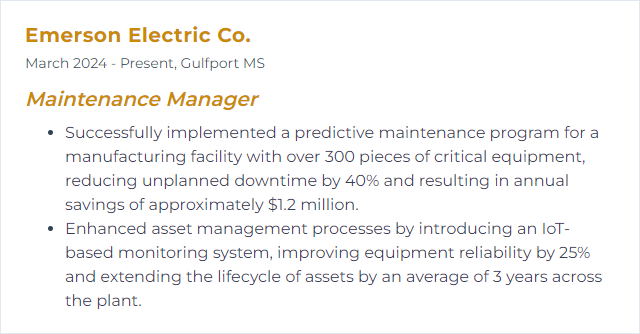
11. Lean Manufacturing
Cut waste, smooth flow, and make problems visible. Maintenance becomes a partner in stability and speed.
Why It's Important
Lean trims downtime and scrap, boosts throughput, and sharpens quality. Maintenance sits in the middle of that flywheel.
How to Improve Lean Manufacturing Skills
Run TPM: Autonomous maintenance, focused improvements, and loss tracking to lift OEE.
5S the workplace: Order, cleanliness, and standards that make anomalies pop.
Standard work: Clear maintenance procedures and visual controls to reduce variation.
Quick changeovers: SMED methods to reduce setup time and cut downtime.
Kanban for spares: Right parts, right place, right time—without hoarding.
Root cause, not band-aids: A3 problem-solving, RCA, and poka-yoke to prevent recurrence.
How to Display Lean Manufacturing Skills on Your Resume
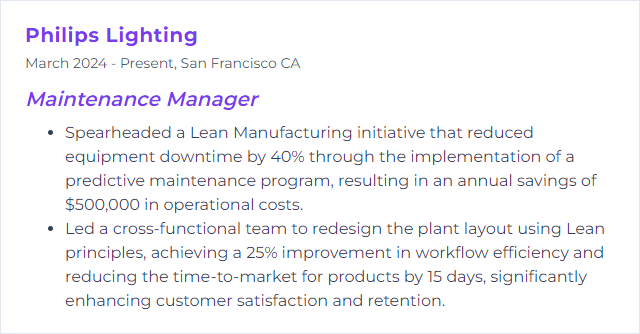
12. Building Automation Systems
Networks of controllers, sensors, and software that coordinate HVAC, lighting, security, and more—data-rich, powerful, and sometimes temperamental.
Why It's Important
BAS cuts energy use, improves comfort, speeds troubleshooting, and enables predictive maintenance when tuned and maintained.
How to Improve Building Automation Systems Skills
Integrate and normalize: Consistent naming, graphics, and point lists across subsystems. One story, many devices.
Trend and analyze: Log key points at useful intervals. Use trends to verify sequences and spot drift.
Right-size alarms: Rationalize setpoints and priorities. Fewer, better alarms get action.
Keep current: Firmware, patches, backups, and documented sequences. No mystery logic.
Secure the system: Role-based access, network segmentation, and regular credential hygiene.
Maintain the hardware: Sensors, actuators, and controllers need calibration and care like any asset.
Train operators: Short playbooks for common adjustments and fault-finding to avoid overcorrection.
How to Display Building Automation Systems Skills on Your Resume
